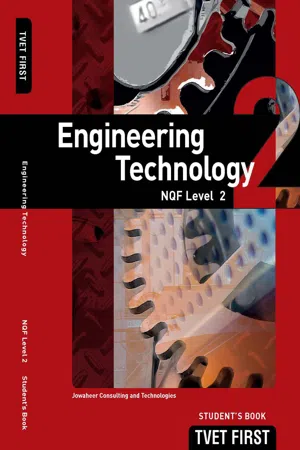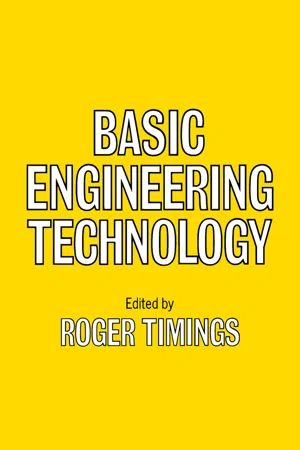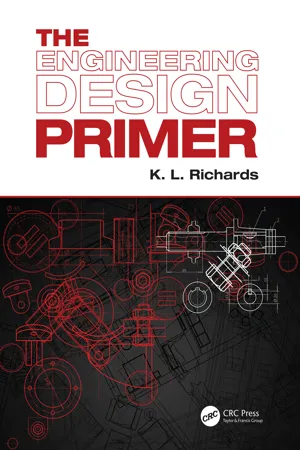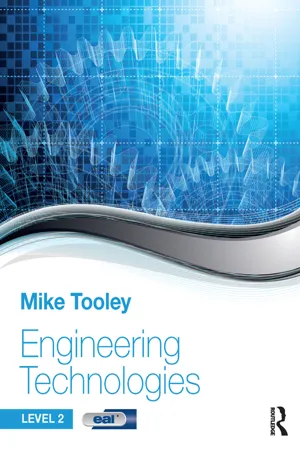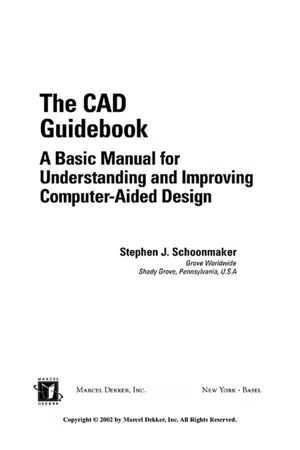Technology & Engineering
Engineering Drawings
Engineering drawings are detailed visual representations of technical designs, typically created using computer-aided design (CAD) software or by hand. They communicate precise information about the size, shape, and structure of components, helping engineers, manufacturers, and construction professionals to understand and execute the design. These drawings often include dimensions, tolerances, materials, and other specifications essential for the production and assembly of the designed object.
Written by Perlego with AI-assistance
Related key terms
1 of 5
11 Key excerpts on "Engineering Drawings"
- eBook - PDF
Engineering Fundamentals
An Introduction to Engineering, SI Edition
- Saeed Moaveni(Author)
- 2019(Publication Date)
- Cengage Learning EMEA(Publisher)
3DDock/Shutterstock.com Engineering Graphical Communication Conveying Information to Other Engineers, Machinists, Technicians, and Managers Copyright 2020 Cengage Learning. All Rights Reserved. May not be copied, scanned, or duplicated, in whole or in part. Due to electronic rights, some third party content may be suppressed from the eBook and/or eChapter(s). Editorial review has deemed that any suppressed content does not materially affect the overall learning experience. Cengage Learning reserves the right to remove additional content at any time if subsequent rights restrictions require it. 637 E ngineers use technical drawings to convey useful information to others in a stan- dard manner. An engineering drawing provides information, such as the shape of a product, its dimensions, materials from which to fabricate the product, and assembly steps. Some Engineering Drawings are specific to a particular discipline. For example, civil engineers deal with land or boundary, topographic, construction, and route survey drawings. Electrical and electronic engineers, on the other hand, deal with printed circuit-board assembly drawings, printed circuit-board drill plans, and wiring diagrams. Engineers also use special symbols and signs to convey their ideas, and show analyses and solutions to problems. In Part Four of this book, we will intro- duce you to the principles and rules of engineering graphical communication and engineering symbols. A good grasp of these principles will enable you to convey and understand information effectively. P A R T 4 CHAPTER 16 Engineering Drawings and Symbols Copyright 2020 Cengage Learning. All Rights Reserved. May not be copied, scanned, or duplicated, in whole or in part. Due to electronic rights, some third party content may be suppressed from the eBook and/or eChapter(s). Editorial review has deemed that any suppressed content does not materially affect the overall learning experience. - eBook - PDF
Engineering Applications
A Project Resource Book
- Graham Simpson, James Ritchie(Authors)
- 2012(Publication Date)
- Butterworth-Heinemann(Publisher)
It is the key information which drives product manufacturing and delivery. As mentioned earlier, the main form in which finalized designs are communicated in an engineering environment is through the use of Engineering Drawings. However, other forms of drawing are usually created before the final formal Engineering Drawings are created and issued for manufacture. Drawings, in many different forms, are used by all types of designers -not only engineers but also architects, product designers and graphic designers. They are used to develop ideas and concepts, to communicate these to other people and to aid the process of detailing manufacturing requirements. Drawings of all types are a communication language understandable by a wide range of people within and outside the company using them, e.g. customers, suppliers, subcontractors and workshop staff. 17 Engineering Applications Designers use all forms of drawings to communicate information, the type and style of drawing used being dependent on the stage of development of the project and the requirements of other people involved in the product design and development process. Drawings do not necessarily imply paper documents; they could also consist of computer-aided design data and information. For the purpose of EA projects the following types of drawing are recommended for the development, presentation and communication of your ideas: • sketches • layout drawings • assembly or general arrangement drawings • detailed part drawings. These are listed in the order in which they are usually created during the design process and are the most common types of drawings used during the design stage of engineering a product. In some cases you may decide to miss out the layout drawing stage and go on to the assembly and/or detail drawing stage depending on the complexity of the idea you are trying to develop. To help you understand the role of each type of drawing we will now describe examples of each. - eBook - PDF
Engineering Technology NQF2 SB
TVET FIRST
- Jowaheer Consulting and Technologies Business Programme Developments(Author)
- 2013(Publication Date)
- Macmillan(Publisher)
• Record keeping: Drawings are kept: – for the ordering of components – to record previous specifications – to record current job specifications in case of faulty design or manufacture. Features of Engineering Drawings Engineering Drawings convey the following critical information: • Geometry: The shape of the object represented as views, i.e. how the object will look when you view it from various angles such as the front, top and side • Dimensions: The size of the object • Tolerances: The allowable variations for each dimension • Material: What the item is made of • Finish: The surface quality of the item. Requirements of Engineering Drawings Engineering Drawings should meet the following requirements: • Unambiguous and clear • Complete • Of a suitable scale • Use symbols instead of words • Conform to the South African Bureau of Standards. Types of drawings The followings are common types of Engineering Drawings: • Design layout drawing: Represents broad principles of a feasible solution • Detailed drawing: A single part drawing containing all information for fabrication • Assembly drawing: Shows how individual parts are combined and refers to a parts list • Arrangement drawing: Shows the finished arrangement of assemblies and includes functional requirements • Diagram: Depicts the function of a system • Drawing list: Cross-reference drawings that combine to produce a single product. 235 Module 7: Basic Engineering Drawings Assessment activity 7.2 Work in pairs 1. State the three main functions of Engineering Drawings. 2. List any two items of critical information that an engineering drawing should convey. 3. List four requirements of an engineering drawing. 4. Match Column A Type of drawing to Column B Explanation. - eBook - PDF
- R L Timings(Author)
- 2014(Publication Date)
- Butterworth-Heinemann(Publisher)
9 Interpreting drawings, specifications and data 9.1 Purpose of technical drawings Designers use technical drawings and speci-fications prepared by draughtspersons to convey their ideas and intentions to such people as: Manufacturing engineers Maintenance/service engineers Sales engineers Customers. These technical drawings and specifications will vary depending upon for whom they are intended. The manufacturing engineer will want orthogra-phic detail and assembly drawings. The service engineer will require exploded views. The cus-tomer will require installation drawings and oper-ating data. Examples of these various types of drawing will be found later in this chapter. Technical drawings and specifications should indicate such information as: (a) The size and shape of the component (b) The material from which it is to be made (c) The finish (corrosion resistant, decorative etc.) (d) The relationship between the component and associated components in an assembly. In addition to the above, data must be provided to give guidance as to: (e) The method of manufacture (operation se-quence) (f) The sequence for assembly and dismantling (g) Installation and operation (h) Performance compared with competing equipment for the benefit of the sales engi-neer. To achieve all these requirements, various types of drawings are widely used. Visual representations avoid the confusion arising in translation from one language to another. Moreover, a drawing is more clear and concise and less open to misinterpre-tation than a verbal description. Most people have a natural instinct for appearance and proportion, and there is much truth in the saying that Tf a product looks right, it is right'. The designer must consider the function and fitness for purpose of a product; in addition, he or she must have a flair for styling and eye appeal, so that the product is attractive to the potential customer. This is par-ticularly important when designing for the general public. - eBook - ePub
- K. L. Richards(Author)
- 2020(Publication Date)
- CRC Press(Publisher)
2Engineering Drawing Principles
2.1 IntroductionThe objective of this chapter is to give the student studying mechanical engineering design the foundations for producing Engineering Drawings that are to be used in the manufacture of an engineering artefact or component. Engineering Drawings are important to manufacturing engineers for all the information that is required to manufacture the part and includes information such as dimensions and tolerances, including surface finishes and material specifications.These days, as companies operate over several continents, Engineering Drawings need to be understood in a number of countries where English is not the first language. It is, therefore, important that the drawings follow the rules that are defined and embodied in the publications of the standards organisations such as the British Standards Institute (BSI) in the United Kingdom, the American National Institute (ANSI) in the United States of America and the Deutsches Institut für Normung (DIN) in Germany. The most important one is the International Standards Organisation (ISO), as this is the world’s overarching standards organisation that determines the standards which subscribing countries adopt in preference to their domestic ones.2.1.1 Technical Product DocumentationTechnical Product Documentation is the term used by the ISO to describe the whole area of design communication, covering the information sufficient for the manufacture of a product and can be described in a number of ways including traditional paper-based drawings. The full title of the ISO Technical Product Documentation (TPD) standard is ISO 29845:2011 TPD.This standard has been adopted by the British Standards Institute (United Kingdom) as BS ISO 29845:2011, and at the time of writing (2017) it was under review. The BSI has a policy that when any ISO standard is published that is relevant to TPD, it is automatically adopted and rebadged as a British Standard. - eBook - ePub
Engineering GNVQ
Intermediate
- Mike Tooley(Author)
- 2012(Publication Date)
- Routledge(Publisher)
This can be made easier by the use of advanced computer aided design (CAD) software. This advanced software enables three-dimensional representations to be prepared by ‘wire-frame’ or solid modelling. Such images can be rotated on the screen so that viewing is possible from all angles. Modifications to the design can be made at the touch of a key. Further, the function of the design can be checked by simulation techniques, before embarking on expensive prototype manufacture.Once these preliminaries have been achieved, the design team will need to consult with representatives of the customer, with maintenance and field service engineers, and with the various bodies responsible for type approval. These may include insurance engineers and Local Authority environmental engineers.Finally the design will need to be proved by the manufacture and testing of a full-scale prototype.Drawing office
Once the design has been approved, technical drawings and specifications will be produced by draughtspersons. These drawings and specifications will vary depending upon for whom they are intended. The manufacturing engineer will want flow charts, and orthographic detail and general arrangement drawings. The service engineer will want circuit diagrams and exploded views. Industrial customers will want installation drawings and operating data. Drawings and specifications are also required for other purposes.Marketing
Formal Engineering Drawings are not appropriate for most customers. Usually, sales material is produced by graphic artists who combine colour photographs with performance data, often in the form of graphs; for example the glossy brochures available in car showrooms. This type of material is closely geared to the potential customer. The pictorial material is usually enhanced by a graphic artist using airbrush techniques.Estimating, costing and planning
These functions are closely linked and involve both engineers and accountants. Fully detailed drawings and specifications are required, together with block diagrams, flow diagrams and spreadsheets. The cost of every component and operation is estimated so that a provisional selling price can be arrived at. Cost targets (budgets) are set and actual production costs are constantly compared with these targets. If the targets are not achieved or improved upon, then either the selling price has to be increased or the manufacturing process modified. Planning involves the economical loading of the work onto the production shops so that the machines are kept fully employed and the work flows smoothly so that delivery dates are achieved and customer goodwill is maintained. - eBook - PDF
- Mike Tooley, Lloyd Dingle(Authors)
- 2010(Publication Date)
- Routledge(Publisher)
Complexity The amount of detail required and the anticipated amount and frequency of development modifications. Cost Engineering Drawings are not works of art and have no intrinsic value. They are only a means to an end and should be produced as cheaply as possible. Both initial and ongoing costs must be considered. Presentation This will depend upon who will see/use the drawings. Non-technical people can visualize pictorial representations better than orthographic drawings. Nowadays technical drawings are increasingly produced using computer aided drawing (CAD) techniques. Developments in software and personal computers have reduced the cost of CAD and made it more powerful. At the same time, it has become more ‘user friendly’. Computer aided drawing does not require the high physical skill required for manual drawing, which takes years of practise to achieve. It also has a number of other advantages over manual drawing. Let us consider some of these advantages: Accuracy Dimensional control does not depend upon the draftsperson’s eyesight. Radii Radii can be made to blend with straight lines automatically. Repetitive features For example, holes round a pitch circle do not have to be individually drawn, but can be easily produced automatically by ‘mirror imaging’. Again, some repeated, complex features need only be drawn once and saved as a matrix. They can then be called up from the computer memory at each point in the drawing where they appear at the touch of a key. Editing Every time you erase and alter a manually produced drawing on tracing paper or plastic film the surface of the drawing is increasingly damaged. On a computer you can delete and redraw as often as you like with no ill effects. Storage No matter how large and complex the drawing, it can be stored digitally on floppy disk. Copies can be taken and transmitted between factories without errors or deterioration. KEY POINT Modelling is use to describe the design stage of a 3-D model or part. - eBook - ePub
Engineering Technologies
Level 2
- Mike Tooley(Author)
- 2016(Publication Date)
- Routledge(Publisher)
As an engineer you must be able to read and use working drawings as well as produce them using both hand-drawn and computer techniques. To avoid confusion, your Engineering Drawings must comply with recommended standards and conventions. You will also need to be able to read schematic diagrams such as those used in electronics, pneumatics and hydraulics. In this section we will introduce you to a common type of engineering drawing known as an orthographic drawing but, before we do, it’s important to realize that this is just one of several types of drawing used in engineering. Formal and informal drawings Engineering Drawings are sometimes referred to as formal or informal. Informal Engineering Drawings, like the one shown in Figure 4.1, can range from quick freehand sketches to simple charts and diagrams. These are intended to convey a quick impression of what something will look like or how something will work. Formal drawings, like the one shown in Figure 4.2, generally take much longer to produce and usually contain a lot more detail. They are also much more precise and often include a scale and dimensions. Figure 4.1 A quick sketch is an example of an informal drawing. Figure 4.2 An example of a formal engineering drawing. Sketches Sketching is one of the most useful tools available to the engineer to express his or her ideas and preliminary designs. Sketches are drawn freehand and they are used to gain a quick impression of what something will look like. Where appropriate, labels, approximate dimensions and brief notes can be added. Engineering drawing isn’t just about using sophisticated computer-aided design (CAD) workstations to produce formal drawings. Being able to produce a quick sketch is often very useful so don’t be afraid to pick up a drawing pad and put your ideas into visual form! Activity 4.1 Produce a 3D sketch of an engineering component like that shown in Figure 4.3 - eBook - ePub
Process Planning
The Design/Manufacture Interface
- Peter Scallan(Author)
- 2003(Publication Date)
- Butterworth-Heinemann(Publisher)
Fig. 3.1 . As can be seen from this figure, a vast amount of information is required during the design process to formulate a design that meets the identified need. In terms of process planning, the most important stage is the detail design. The output of the detail design is a complete description of the product in written and/or graphical form. The main thrust of this output will be the Engineering Drawings. These should contain all the information required to convey the design representation and are therefore a major input to the process planning activity.Figure 3.1 Information flow in the design process(adapted from Hamilton et al., 1988 )3.3.2 Engineering drawing
The purpose of this section is to introduce the different types of Engineering Drawings used in manufacturing and how they may, or may not, be used in process planning. In engineering, the drawing is the most common form of communication and is accepted as a universal language. There are several types of drawings used in industry. These are (Parker, 1984):• detail drawings; • assembly drawings; • combined drawings.These are briefly introduced below by way of a short explanation and an exemplar.Detail drawings
Detail drawings contain all the information required to manufacture the item or items represented. This information will include all dimensions, tolerances, surface finish specifications, and material specifications. There are two different types of detail drawing. These are:• single-part drawings; • collective drawings.A single-part drawing should show all the information required to completely define the manufacture of a single item. This will include the form, dimensions, tolerances, material, special treatments, surface finishes, etc. It should be noted that a drawing might consist of more than one sheet. The complexity of the part will also determine the number of views required to satisfactorily detail the part. An example is illustrated in Fig. 3.2 .Figure 3.2 Single-part drawingThere are also collective single-part drawings. These drawings show essentially similar parts where only one or more details differ from the rest. These are used for standard parts such as nuts, bolts, washers, etc. as illustrated in Fig. 3.3 - eBook - ePub
The CAD Guidebook
A Basic Manual for Understanding and Improving Computer-Aided Design
- Stephen J. Schoonmaker, Lynn Faulkner(Authors)
- 2002(Publication Date)
- CRC Press(Publisher)
table 4.3 indicates whether the type of drawing is of this type.4.7.1 Engineering Sketches
An engineering sketch is assumed to be less than a normal drawing. Instead of documenting a design for production and sale, this drawing would be used to document a prototype or basic parameters for a potential product. It may not have a format at all. In many cases, the sketch is made by an engineer (often primarily responsible for calculations); while official drawings are made by designers (often primarily responsible for commercialization of a new product).4.7.2 Layouts
A layout drawing is often also not a normal drawing. It is a special drawing that often is a master of the released drawings. This is where components are shown in the context of the entire design, to basically figure out how things fit. For a car, the layout drawing would actually look like many views of the car, and the position of the engine, doors, etc. would be determined from this drawing. This can still be done with 2-D CAD software, but much more typically this type of activity is done with 3-D models instead.Often the layout drawing would be controlled by a head designer for a product. This drawing would then be used by other designers in the more detailed design of “lesser” assemblies. Some CAD software uses data management methods to continue this paradigm with 2-D CAD data shown overlaid or as layers. The master designer can change the layout, but the lesser assembly designers are not allowed by the software to alter the overall layout. Again, 3-D CAD generally does an even better job with this project control function.4.7.3 Details
A “detail” drawing is really a drawing of a single component within a larger design. It is a drawing of a single Part. It usually has an assigned number called the Part number. The detail drawing should be completely sufficient to have someone manufacture the Part. Using the car analogy, the button one would press to open a door on a car would be a single Part. This button would have a drawing of its own, and the button would have a Part number and be manufactured as a discreet item. A drawing showing just this button could then be called a detail (or a detail drawing). - Available until 27 Nov |Learn more
- Karen Hansen, Kent Zenobia, Karen Lee Hansen, Kent E. Zenobia(Authors)
- 2011(Publication Date)
- Wiley(Publisher)
Table 6.2 for a comparison. The most obvious difference is that drawings largely contain information in graphical/geometric format and specifications contain information in text format. The level of detail included in the drawings and specifications corresponds to the needs of the client, of permitting and regulatory agencies, and of the contractor. The following sections discuss further the content and organization of drawings and specifications.Table 6.2 Information Contained in Construction Drawings versus Technical Specifications.
DrawingsConstruction Drawings Technical Specifications • Design requirements represented graphically • Design requirements represented verbally • Size, shape, and relationship of elements provided • Properties and characteristics of elements provided • Location of elements depicted • Installation requirements for elements established • Products or materials shown wherever located • Products or materials described once • Products or materials shown generically • Products or materials identified specifically • Quantity indicated • Quality indicated • Few requirements for testing noted • Requirements for testing clearly spelled out Drawings depict the location, size, shape, and dimensional relationships of design elements, in addition to materials. A drawing set typically includes site and building plans, elevations, sections/profiles, details, and schedules (matrices or tables, not time-based schedules). Each drawing should include sufficient information to orient the user, including scale, a north arrow on plans, and key plans that locate partial plans within the whole. Each sheet in the drawing set also should contain:
Index pages curate the most relevant extracts from our library of academic textbooks. They’ve been created using an in-house natural language model (NLM), each adding context and meaning to key research topics.


